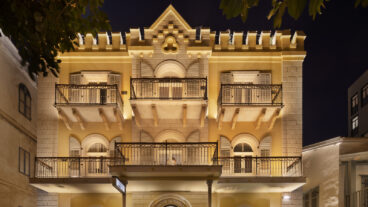Zivia’s folding chair exemplifies the rough characteristics of all the designs on display.Israelis have studied design since long before the creation of the State. In fact, one of the premier design schools in the country, Jerusalem’s Bezalel Academy for Art and Design, is celebrating the 100th anniversary of its founding this year.
So it may come as a surprise to learn that Solos: New Design from Israel, a new exhibition opening this month at Smithsonian’s Cooper Hewitt museum in New York, will be the first-ever museum exhibition of contemporary Israeli design in the United States.
The exhibition (January 27-April 23) is organized by guest curator Ezri Tarazi, head of the industrial design graduate program at Bezalel Academy for Art and Design in Jerusalem, and Ellen Lupton, curator of contemporary design at Cooper-Hewitt.
The seeds of the exhibition were planted through a meeting between Tarazi and Barbara Bloemink, the curator and acting director of the Cooper Hewitt, in 2003. Veteran curator Lupton was brought into the project and visited Israel in December of the following year. Lupton says it was this visit that brought the theme of the exhibition into focus.
“When I spent a day meeting with Israeli designers, the theme of imperfect things recurred across many of the piece and seemed to reflect something present in the cities and landscape as well,” Lupton told ISRAEL21c.
“We could have done an exhibition about high tech designs – medical equipment and so forth – but the human quality of these pieces, their personal and philosophical messages, seemed right for a museum exhibition,” she says. “These objects invite thought and reflection.”
For example, designer Zivia’s two entries in the exhibition, a folding chair and an upright chair, exemplify the rough characteristics of all the designs on display, while also hinting at the distinctively Israeli cultural roots to her concepts. Both chairs are constructed with plywood and swatches of textiles and fabrics, all endemic to Israel.
“[The designs use materials that] are typical to nomadic societies. I use Israeli materials which is a very typical textile for traditional uses here in Israel,” she told ISRAEL21c.
Tarazi cites Israel’s cultural diversity as a driving factor which influences Israeli design, and what emerges is complex and rich in color and texture. Unlike the ‘dry’ and ‘clean’ designs that come out of Europe, Israel’s designs have more in common with Brazil, he says. Another influence on the form of Israeli designs is the type of work that exists for designers in Israel.
In Israel, Tarazi explains, many designers make their living from industrial designs, in the development of high tech components or medical equipment that from the cornerstones of Israel’s world-class technology industries. After work, however, these designers return to their own studios. There, many produce vastly different creations for their own pleasure, produced with whatever materials that are at hand: One-off designs that are rough, yet bold, and importantly, not intended for mass-production.
“It frees the designers from client’s tastes, from [following the dictates of] the market of the design world,” says Tarzai.
As a result, adds Ezri, “You can see in the exhibition a lot of very free ideas.”
Part of the creative freedoms expressed in the exhibition may well be traced back to the Bezalel Academy itself, where most of the designers featured in the exhibition have studied at one time or another.
“[The Bezalel Academy] maintains some sort of an independence from other schools,” says designer Alon Meron. “There is an unwritten agreement between a student and the Academy, which says that the student goes to the Academy and they teach you what you’re supposed to know [in order to find work in Industrial Design] but they also leave you the freedom to do what you want.”
“I think the Academy is the place where you get the most freedom of all the academies in Israel.”
“There has been a great renaissance in Israeli design in the last five years,” says Tarazi, using the examples of numerous exhibitions in Europe and the Far East which Israeli designers have taken part in during that time.
Tarazi also brings up the example of Mel Byars, the author of over a dozen books on design, including the Design Encyclopedia, published by New York’s Museum of Modern Art. Byars, who is not Jewish and has no other connection to Israel, moved to Israel in recent years to take part in its vibrant design community.
Byars, says Tazari, wrote several years ago that Israel was the best kept secret in the design world. The best kept secret is gradually leaking out, something which has not escaped the notice of the designers themselves.
“Ellen Lupton writes that exhibiting in the Cooper Hewitt is bringing Israeli design to the global attention,” says Zivia. “I think that the global attention is looking for the next hot thing to talk about, and maybe it can be Israeli design.”












